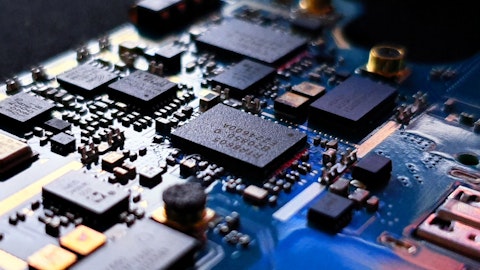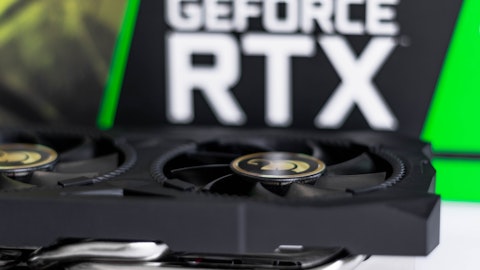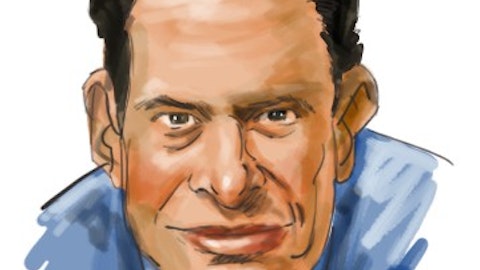Operator: Thank you. Our next question comes from Martin Yang with Oppenheimer. You may proceed.
Martin Yang: Hi. Thank you for taking my question. Michael, I have a question regarding your wireless roadmap at the time of acquisition from Broadcom, you did have – I mentioned to the back has two road map products. Can you give us update on where you are today with roadmap products? And what’s your plans are after the two products or after you have exhausted the two roadmap products?
Michael Hurlston: Yes. Good question. Thank you, Martin. I would say the volume. So on the two roadmap products, both are sampling and one is nearing production. So we’ve got both of those products in our hands. We’re actually pleased with the performance of both. Both are in 16-nanometer, which we think gives us a pretty good competitive footing particularly on a power – from a power standpoint. And in parallel, we brought up our own engineering capabilities. So we’ve actually taped out our first set of products that are done with our internal engineering team, and we expect that part of the vision that I am outlining here is, we really want to become a major player. Today, we’ve got a very small share, I would say in this IoT landscape as it relates to wireless.
We have really retooled our road map. And I think part of what you’re going to see is very targeted ships, a litany of very targeted ships coming from different segments of this IoT market that will be done by our internal team. So we’ve adjusted our spend to make sure that our wireless opportunity is well served, because we believe this is actually the biggest TAM that we have in front of us. And if we execute to, what I believe we can, I think we’re going to be in really, really good shape. So wireless is a big part of our story, we’ve had this bridge that we got from these Broadcom designs, but we’re beginning to really hit the ground running with our internal capability and I’m pretty optimistic that we have a plan to really make this thing into big, big business for us.
Martin Yang: Thank you, Michael. I have one more question on the automotive display opportunity. At CES, we saw a demo for mini LED backlighting driver. Can you maybe give us more details on that market? Do you – how unique are you coupling the driver chip with TDDI? And who are you competing with for that LED driver – video LED backlighting drivers?
Michael Hurlston: Yes. So the thing that we have, Martin, I mean we have, as you know, being around the company for some time, our big opportunity is in TDDI. So the state of the automotive market is still the predominant number of cars on the road have discrete touch circuits and discrete display drivers for the infotainment system. That’s converting to TDDI, where you have integrated touch and integrated display in one circuit. What we introduced at CES is a bridge product. So now there is an additional chip that takes input from the applications processor, converts it from EDP is kind of a standard format that it gets sent to the display to LVDS, Low-Voltage Differential, that goes into the display. So this is a chip that’s there today, since in almost every car to convert from the applications processor up to the display.
What’s unique, what we’ve been able to add is this technology called local dimming. And in local dimming, that’s where this backlighting comes into play. We’re actually able to make the contrast ratio much, much sharper. Your blacks are very deep, your whites are much brighter, and that’s a differentiator. As we think about this is a great opportunity for us, because there is additional content that we can gain. We have some differentiation there. And we actually see more and more of our focus as we go forward, playing into the SmartBridge area, where we think there are different pieces of puzzle we can bring to bear over the next couple of years. So, hopefully, that answers your question. I like that opportunity and I think for us automotive, as we said, it’s one of our three focus areas.
And I think that if we play our cards right, we can really increase our content over time.
Martin Yang: Got it. Yes, you answer my questions. Thank you.
Operator: Thank you. Our next question comes from Ambrish Srivastava with BMO Capital Markets. You may proceed.
Unidentified Analyst: Hi, guys. This is Jamison on for Ambrish. I’m hoping you guys could maybe just give a little bit more color on this IoT Processor pushout. Just looking at it, it sounds like it’s about a $30 million pushout. So if this is correct, does it imply that in December it would have been closer to $200 million, just given your guidance? And second, as inventory clears through the first half, is it reasonable to think that this IoT segment can hit 300 number – $300 million number again sometime in the second half of calendar ’23? Thank you.
Dean Butler: Yes, Jamison. This is Dean. Let me give you just a little bit more about this customer engagement that pushed out from December, we got delayed into March now. It depending on sort of the milestones and various deliverables, it’s sort of between sort of 10 and 30. So that’s sort of the ranging depending on what deliverables are sort of met in any particular quarter. So that’s sort of the rough range. We said it’s kind of about 100 basis points and sort of margin impact, depending on what quarter is that – the deal actually ends up getting completed and the major deliverables done. On the IoT side, basically this is where a lot of the inventory consumption really is happening, this is where sell through is highly dependent on our sell-in.
So what we’re looking at is, you’re really trying to let our customer base sort of consume on their side, on the OEM side, which then needs to eat their inventory or put it on a distributor side. And so the timing on how both of those elements of inventory gets burned down really sort of depends on how the specific timeline of sort of return to normal demand consumption. I mean, I think the thing to remember here Jamison is largely, this is a work known as inventory, and there hasn’t really been any fundamental shift in the business and sort of what we’re pursuing and the growth drivers around it. And so that’s I think how most people should think about it.
Unidentified Analyst: Okay, wonderful. Thank you. And then I guess just following-up with this maybe the best visibility just to rank order for your – I guess, to your best ability for inventory, I guess in channel drain would be PC first, it sounds like mobile second in IoT is kind of a little bit more murky. Is that the correct way to frame it?
Michael Hurlston: You got it. Yes. We’re just comparing notes here and it matched exactly what you said, yes. I think PC looks like it’s getting better. And we have – part of our IoT business is sort of attached to PC indirectly, I think that’s getting better, mobile sort of second, and IoT third. And to your point, I mean, we expect to get back to sort of normal IoT levels, timing is a question as Dean said, but I don’t expect this to be a persistent problem.
Unidentified Analyst: Of course. Well, thank you so much. Appreciate it.
Michael Hurlston: Thanks, Jamison.
Operator: Thank you. And I’m not showing any further questions at this time. I would now like to turn the call back over to Michael Hurlston for any further remarks.
Michael Hurlston: I’d like to thank all of you for joining us today. We certainly look forward to seeing you at our upcoming investor conferences and speaking to you further during the quarter. Thank you.
Operator: Thank you. This concludes today’s conference call. Thank you for participating. You may now disconnect.
Follow Synaptics Inc (NASDAQ:SYNA)
Follow Synaptics Inc (NASDAQ:SYNA)
Receive real-time insider trading and news alerts





